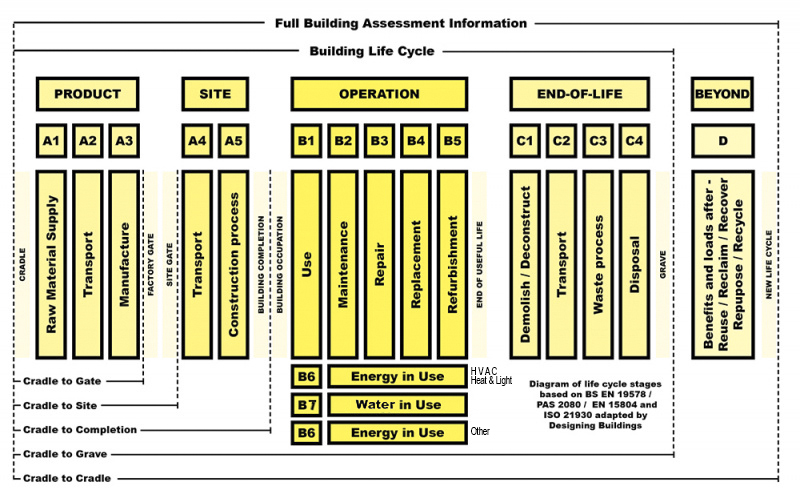Mandatory and optional environmental impact categories
EN 15804+A2 Sustainability of construction works - Environmental product declarations - Core rules for the product category of construction products - is the updated EN 15804 standard and refers to the full life cycle assessment including all stages of use.
[edit] Mandatory environmental impact categories
The updated EN 15804+A2 adjusts the list of mandatory environmental impact categories to include a greater level of definition:
- Climate Change - Total (CCT)
- Climate Change - Fossil (CCF)
- Climate Change - Biogenic (CCB)
- Climate Change - Land-use and Land Use Change (LULUC)
- Ozone Depletion Potential (ODP) - Ozone Depletion
- Photochemical ozone creation potential (POCP) - Photochemical ozone formation
- Acidification - (AP)
- Eutrophication aquatic freshwater - (EPAF)
- Eutrophication aquatic marine - (EPAM)
- Eutrophication terrestrial - (EPT)
- Abiotic depletion potential for minerals and metals (ADPMM)
- Abiotic depletion potential for fossil resources (ADPFR)
- Water use (WU)
[edit] Optional environmental impact categories
The updated EN 15804+A2 also has addition and optional environmental impact categories for EN 15804+A2, PEF; for stages A1-A3 and A4-A5, plus B1-7, C1-3 and D.
EN 15804+A2 disclaimer for Ionizing radiation, human health. This impact category deals mainly with the eventual impactof low dose ionizing radiation on human health of the nuclear fuel cycle. It does not consider effects due to possible nuclear accidents, occupational exposure or waste disposal. Potential ionizing radiation from the soil, from radon and from some construction materials is also not measured by this indicator.
- Particulate matter (Incidence)
- Ionizing radiation, human health (kBq U235e)
- Eco-toxicity (freshwater) CTUe
- Human toxicity, cancer effects (CTUh)
- Human toxicity, non-cancer effects (CTUh)
- Land use related impacts/soil quality
TRACI 2.1
- Global warming potential kg CO2e
- Ozone depletion kg CFC11e
- Photochemical smog formation kg O3e
- Acidification kg SO2e
- Eutrophication kg Ne
- Depletion of non-renewable energy MJ
Use of Natural Resources
- Renewable PER used as energy MJ
- Renewable PER used as materials MJ
- Total use of renewable PER MJ
- Non-renew. PER used as energy MJ
- Non-renew. PER used as materials MJ
- Total use of non-renewable PER MJ
- Use of secondary materials kg
- Use of renewable secondary fuels MJ
- Use of non-renew. secondary fuels MJ
- Use of net fresh water m3
PER abbreviation stands for primary energy resources
- Hazardous waste kg
- Non-hazardous waste kg
- Radioactive waste kg
End-of-Life Output flows
- Components for reuse kg
- Materials for recycling kg
- Materials for energy recovery kg
- Exported energy MJ
[edit] Related articles of Designing Buildings
- An in-depth look at Environmental Product Declarations EPDs.
- British Standards
- BS EN 15978-1
- Collaboration, standards and their acronyms explained.
- European Standards
- Environmental product declaration EPD
- EN 15804+A1 2012
- International Standards
- Mandatory environmental impact categories
- Optional environmental impact categories
- Product Environmental Footprint PEF
- Product category rules PCR.
- Sustainable procurement.
- The sustainability of construction works.
Featured articles and news
RTPI leader to become new CIOB Chief Executive Officer
Dr Victoria Hills MRTPI, FICE to take over after Caroline Gumble’s departure.
Social and affordable housing, a long term plan for delivery
The “Delivering a Decade of Renewal for Social and Affordable Housing” strategy sets out future path.
A change to adoptive architecture
Effects of global weather warming on architectural detailing, material choice and human interaction.
The proposed publicly owned and backed subsidiary of Homes England, to facilitate new homes.
How big is the problem and what can we do to mitigate the effects?
Overheating guidance and tools for building designers
A number of cool guides to help with the heat.
The UK's Modern Industrial Strategy: A 10 year plan
Previous consultation criticism, current key elements and general support with some persisting reservations.
Building Safety Regulator reforms
New roles, new staff and a new fast track service pave the way for a single construction regulator.
Architectural Technologist CPDs and Communications
CIAT CPD… and how you can do it!
Cooling centres and cool spaces
Managing extreme heat in cities by directing the public to places for heat stress relief and water sources.
Winter gardens: A brief history and warm variations
Extending the season with glass in different forms and terms.
Restoring Great Yarmouth's Winter Gardens
Transforming one of the least sustainable constructions imaginable.
Construction Skills Mission Board launch sector drive
Newly formed government and industry collaboration set strategy for recruiting an additional 100,000 construction workers a year.
New Architects Code comes into effect in September 2025
ARB Architects Code of Conduct and Practice available with ongoing consultation regarding guidance.
Welsh Skills Body (Medr) launches ambitious plan
The new skills body brings together funding and regulation of tertiary education and research for the devolved nation.
Paul Gandy FCIOB announced as next CIOB President
Former Tilbury Douglas CEO takes helm.
UK Infrastructure: A 10 Year Strategy. In brief with reactions
With the National Infrastructure and Service Transformation Authority (NISTA).
























